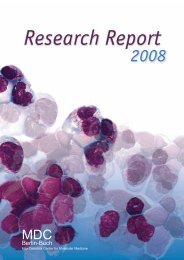iMDC03 zum Download (pdf)
iMDC03 zum Download (pdf)
iMDC03 zum Download (pdf)
Erfolgreiche ePaper selbst erstellen
Machen Sie aus Ihren PDF Publikationen ein blätterbares Flipbook mit unserer einzigartigen Google optimierten e-Paper Software.
The Quest to Understand “How Life Works”<br />
The Quest to Understand<br />
“How Life<br />
Works”<br />
Leibniz Prize Recipient Nikolaus Rajewsky Explains His Research<br />
text Josef Zens Photos David Ausserhofer<br />
Tran s lation Carol Oberschmidt<br />
Snow has fallen overnight, covering the campus and glistening like sugar in the<br />
sunlight. It is Friday morning and the thermometer reads minus 7 degrees Celsius.<br />
As part of a photo shooting, Professor Nikolaus Rajewsky, one of the Leibniz prizewinners<br />
for 2012, is walking back and forth under his office window. Fortunately,<br />
his brown hiking boots are made for this weather. From Rajewsky’s office window<br />
on the first floor, David Ausserhofer is taking still photos to create a short video<br />
clip about the designated prizewinner. It will be shown at the Leibniz Prize award<br />
ceremony, enabling the guests to get better acquainted with the person behind<br />
the researcher.<br />
In an interview before the shooting with the German Research Foundation (DFG),<br />
Professor Rajewsky discussed his research. At the end, the interviewer asks how he<br />
would describe his research in one sentence. He thinks for a long moment and then<br />
says: “Gene interactions are a key to understanding how life works.”<br />
Professor Rajewsky’s primary research interest is the investigation of this interaction.<br />
He compares his work to that of a photographer taking a flash photo in a dark<br />
room. “Like in a snapshot, we can see for the first time how genes communicate with<br />
each other.” His main focus is on a special type of molecule, RNA. For a long time RNA<br />
was considered to be only a transmission medium that carried the message of certain<br />
segments of the DNA into the factories of the cells, which in turn produce certain<br />
proteins, depending on the blueprint. However, scientists have known for about ten<br />
years that RNA does not merely connect two cog wheels like a bicycle chain, transmitting<br />
information one to one. Rather, it works more like an automatic transmission,<br />
up- or down-regulating the activities in the cells or even switching them to “off”.<br />
Nikolaus Rajewsky has made a major contribution to the discovery of these<br />
relationships. In its justification statement for awarding him the Leibniz Prize, the<br />
jury emphasized the importance of his work on microRNAs – small non-coding RNAs<br />
that play a key role in controlling cellular processes but also in the development of<br />
cancer and other diseases.<br />
At first, the life sciences played a subordinate role in his career. Mathematics<br />
and physics were in the foreground – and music. He completed training as a concert<br />
pianist, earning an Artist Diploma. However, he chose a career in science and<br />
decided to do his PhD in Cologne in theoretical physics. After a first post-doctoral<br />
fellowship in New Jersey (USA), he went on to a second postdoc at Rockefeller<br />
University in New York. He then became an assistant professor at New York<br />
University, where he focused on systems biology. According to the German<br />
Research Foundation, “Nikolaus Rajewsky has set new standards in systems<br />
biology and enriched the life sciences as a whole.”<br />
He returned to Germany in 2006. What motivated him to make the move?<br />
10 imdc03 2012
















